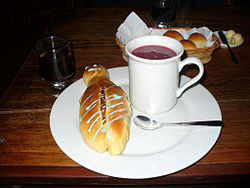| This article needs additional citations for verification. Please help improve this article by adding citations to reliable sources. Unsourced material may be challenged and removed. Find sources: "T'anta wawa" – news · newspapers · books · scholar · JSTOR (September 2014) (Learn how and when to remove this message) |
You can help expand this article with text translated from the corresponding article in Spanish. (May 2010) Click for important translation instructions.
|
 T'anta wawa served with colada morada T'anta wawa served with colada morada | |
| Type | Sweet roll |
|---|---|
| Region or state | Central Andes |
| Main ingredients | Wheat flour |
T'anta wawa ("bread baby", from Aymara and Quechua t'anta "bread" and wawa "child, baby"; hispanicized names: guagua de pan, tantaguaguas, tantahuahua, wawas de pan, tantawawas and muñecas de pan) is a type of sweet roll shaped and decorated in the form of a small child or infant. They are generally made of wheat and sometimes contain a sweet filling. They are made and eaten as part of ancestral rites in Andean regions of Bolivia, Ecuador, Peru, the south of Colombia, and the north of Argentina, mainly on All Souls' Day, but also as part of agricultural festivals, carnivals, and Christmas.
Regional characteristics
Ecuador
T'anta wawa are consumed on November 2 all over the Andean region. They are eaten with colada morada. They are made by families and exchanged among groups of family and friends and given to godchildren. In rural cemeteries and indigenous communities, such as Tungurahua Province, they are used as offerings as part of a ceremony of encounter with one's ancestors.
Peru
The bread guaguas, tanta wawas or tantaguaguas are part of the celebrations on All Souls' Day especially in Ayacucho, Junin, Ancash, Pasco, Puno, Tacna, Apurimac, Cusco and Arequipa.
See also
References
- Radio San Gabriel, "Instituto Radiofonico de Promoción Aymara" (IRPA) 1993, Republicado por Instituto de las Lenguas y Literaturas Andinas-Amazónicas (ILLLA-A) 2011, Transcripción del Vocabulario de la Lengua Aymara, P. Ludovico Bertonio 1612 (Spanish-Aymara-Aymara-Spanish dictionary)
- Teofilo Laime Ajacopa (2007). Diccionario Bilingüe Iskay simipi yuyayk'ancha [Quechua-Spanish dictionary]. La Paz.
{{cite book}}: CS1 maint: location missing publisher (link) - Diccionario Quechua - Español - Quechua [Quechua-Spanish dictionary]. Cusco: Academía Mayor de la Lengua Quechua, Gobierno Regional Cusco. 2005.
| Allhallowtide | ||
|---|---|---|
| Main topics |  | |
| Traditions | ||
| Food | ||
| Hymns | ||
| Theology | ||
| Related observances | ||
This Ecuadorian cuisine-related article is a stub. You can help Misplaced Pages by expanding it. |
This Peruvian cuisine-related article is a stub. You can help Misplaced Pages by expanding it. |